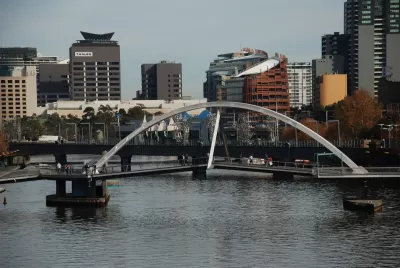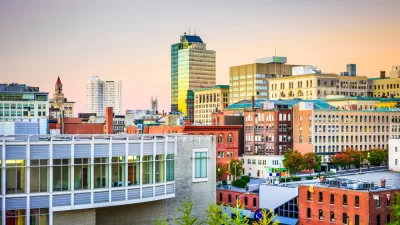Melbourne's long-range plan for development through 2050 envisions denser neighborhoods, built around the idea of 20-minute neighborhoods.

The Plan Melbourne 2017-2050 long-range plan released last week has offered some innovative changes to the city's current planning scheme to address an anticipated growth from 4.5 million to 8 million residents between now and 2050. The plan would remove current limitations that only permits two dwelling units per residentially zoned lot. Urban Development Institute of Australia Victorian CEO Danni Addison is supportive of the proposed density increases, noting that it will give middle- to low-income resident an opportunity to live in Melbourne's inner suburbs. John Masanauskas of the Herald Sunreports that the plan's detractors worry about the loss of the city's suburban character, losing its livability and becoming "a concrete jungle."
However, the plan has also introduced requirements for maintenance of minimum garden space for lots greater than 400 square meters (approx. 4,300 sq. ft), which has earned the support of residents who love their "Aussie backyard". The plan also seeks to create 20-minute neighborhoods that will allow residents to access basic needs within a 20-minute trip without the use of a car.
The concept involves reducing car use by encouraging more active modes of transport while creating mixed-use community areas of varying densities.
Under Plan Melbourne 2017-2050, people should be able to meet most of their everyday needs within a 20-minute walk, cycle or public transport trip from their home, but not including travel to work.
Each neighbourhood would have an activity centre with shops, cafes, service businesses and community hubs, while residents would also have access to local schools, sporting facilities and parks.
The Plan Melbourne 2017-2050 document can be found online, here.
FULL STORY: Andrews Government to force developers to offer minimum garden space under Plan Melbourne

Manufactured Crisis: Losing the Nation’s Largest Source of Unsubsidized Affordable Housing
Manufactured housing communities have long been an affordable housing option for millions of people living in the U.S., but that affordability is disappearing rapidly. How did we get here?

Americans May Be Stuck — But Why?
Americans are moving a lot less than they once did, and that is a problem. While Yoni Applebaum, in his highly-publicized article Stuck, gets the reasons badly wrong, it's still important to ask: why are we moving so much less than before?

Using Old Oil and Gas Wells for Green Energy Storage
Penn State researchers have found that repurposing abandoned oil and gas wells for geothermal-assisted compressed-air energy storage can boost efficiency, reduce environmental risks, and support clean energy and job transitions.

Minneapolis Bans Rent-Setting Software
Four cities have enacted restrictions on algorithmic software that can inflate rent costs.

Oakland to Add 244 New EV Chargers
Oakland plans to launch its new charging network at eight locations by the end of 2025.

Jane Goodall Inspires with Message of Hope, Resilience, and Environmental Action
Speaking in Pasadena, Jane Goodall offered a hopeful and inspirational message, urging global compassion, environmental responsibility, and the power of individual action to shape a better future.
Urban Design for Planners 1: Software Tools
This six-course series explores essential urban design concepts using open source software and equips planners with the tools they need to participate fully in the urban design process.
Planning for Universal Design
Learn the tools for implementing Universal Design in planning regulations.
Heyer Gruel & Associates PA
City of Moreno Valley
Institute for Housing and Urban Development Studies (IHS)
City of Grandview
Harvard GSD Executive Education
Salt Lake City
NYU Wagner Graduate School of Public Service
City of Cambridge, Maryland





























